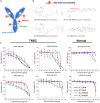A rationally designed ICAM1 antibody drug conjugate eradicates late-stage and refractory triple-negative breast tumors in vivo
- PMID: 37146146
- PMCID: PMC10162665
- DOI: 10.1126/sciadv.abq7866
A rationally designed ICAM1 antibody drug conjugate eradicates late-stage and refractory triple-negative breast tumors in vivo
Abstract
Triple-negative breast cancer (TNBC) remains the most lethal form of breast cancer, and effective targeted therapeutics are in urgent need to improve the poor prognosis of TNBC patients. Here, we report the development of a rationally designed antibody drug conjugate (ADC) for the treatment of late-stage and refractory TNBC. We determined that intercellular adhesion molecule-1 (ICAM1), a cell surface receptor overexpressed in TNBC, efficiently facilitates receptor-mediated antibody internalization. We next constructed a panel of four ICAM1 ADCs using different chemical linkers and warheads and compared their in vitro and in vivo efficacies against multiple human TNBC cell lines and a series of standard, late-stage, and refractory TNBC in vivo models. An ICAM1 antibody conjugated with monomethyl auristatin E (MMAE) via a protease-cleavable valine-citrulline linker was identified as the optimal ADC formulation owing to its outstanding efficacy and safety, representing an effective ADC candidate for TNBC therapy.
Figures






References
-
- Siegel R. L., Miller K. D., Fuchs H. E., Jemal A., Cancer statistics, 2021. CA Cancer J. Clin. 71, 7–33 (2021). - PubMed
-
- Lee A., Djamgoz M. B. A., Triple negative breast cancer: Emerging therapeutic modalities and novel combination therapies. Cancer Treat. Rev. 62, 110–122 (2018). - PubMed
-
- Foulkes W. D., Smith I. E., Reis-Filho J. S., Triple-negative breast cancer. N. Engl. J. Med. 363, 1938–1948 (2010). - PubMed
-
- Dent R., Trudeau M., Pritchard K. I., Hanna W. M., Kahn H. K., Sawka C. A., Lickley L. A., Rawlinson E., Sun P., Narod S. A., Triple-negative breast cancer: Clinical features and patterns of recurrence. Clin. Cancer Res. 13, 4429–4434 (2007). - PubMed
MeSH terms
Substances
LinkOut - more resources
Full Text Sources
Miscellaneous

